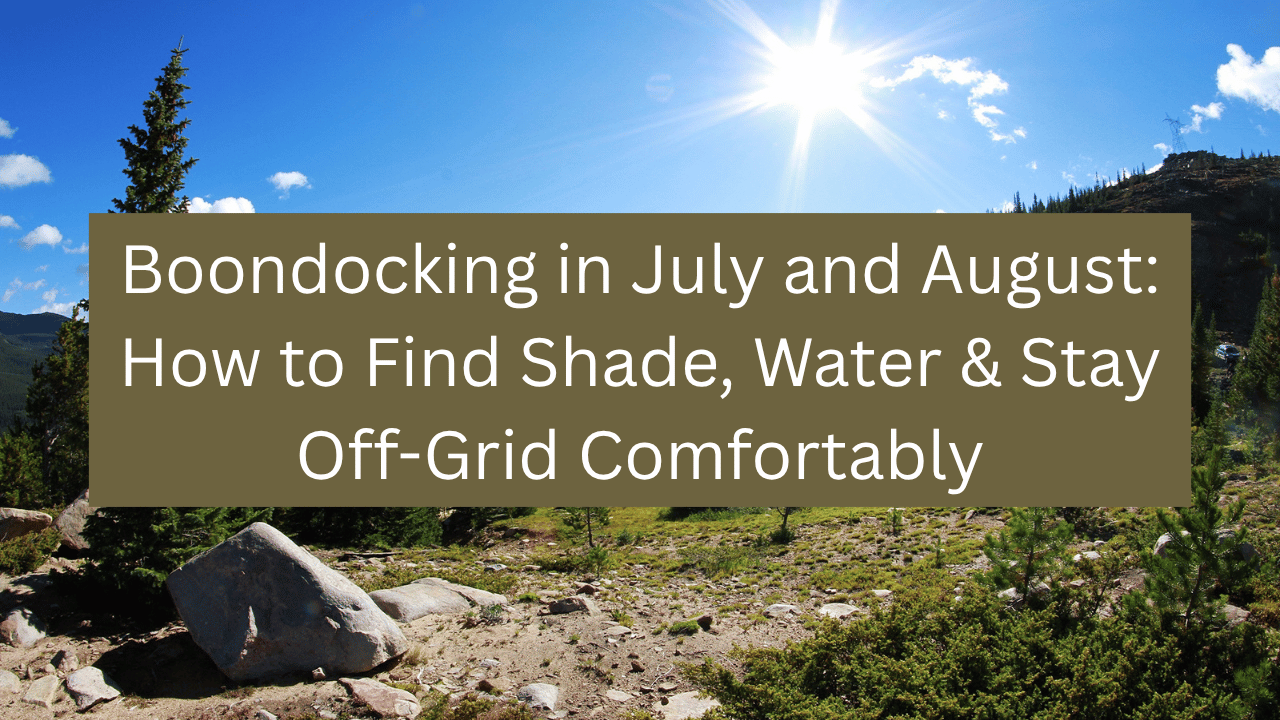Posted by
on
Summer boondocking means secret camping spots, off-grid national forest hide-aways, unforgettable sunsets—and some serious heat. July and August are prime months for off-grid exploration, but they also test your RV’s systems and your sanity if you’re not prepared. Whether you’re high up in the mountains or low on the Plains, with a goal of staying unplugged, here are smart, field-tested tips to help you find shade, stay healthy and safe, and beat the heat off-grid.

When planning your summer boondocking route, elevation is your best friend. For every 1,000 feet you climb, temperatures drop roughly 3.5°-5.5 F. So if it is 100°F in the valley, it might be a pleasant 80°F at 6,000 feet. Apps like Campendium and iOverlander list elevations, making it easy to search for higher-altitude spots in national forests or BLM land.
Boondocking Gems in High Elevation (July–August):
Shade becomes a precious resource during peak summer sun. When scouting a spot:
💡 Pro Tip: If you have solar, park so your panels get maximum sun while the rest of your rig stays shaded. I carry portable solar panels that plug into the outside of my RV so I can park in the shade and still charge my batteries.
Hot weather = higher water consumption. Between drinking, dishes, and rinsing off the sweat, you’ll need a solid strategy to stretch your water supply. And don’t forget your four-legged friends! Make sure you have enough water to keep your furbabies hydrated and cool too!
Tips to Make Your Water Last Longer:
Where to Refill Off-Grid:
Smart airflow management is your off-grid A/C. You don’t need shore power to stay cool if you plan it right.
Off-Grid Cooling Tactics:
💡 Pro tip: On warmer nights, I close all my windows except the one by my bed and turn on a roof fan to suck the cooler air in over my bed through the open window. This allows the cool air to be funneled through the one window and keeps Sadie and me cool!
The high solar gain in summer is a plus—if you can stay cool while your panels soak it up.
For Efficient Power Management:
Don’t forget your own (and your furry companions) comfort and safety.
People Tips:
Pet Tips:
Sometimes it’s just too hot. That’s OK.
Always Have a Backup Plan:
Boondocking in July and August is entirely doable with the right gear, mindset, and strategy. It takes planning to stay safe and comfortable. If you’re chasing freedom on four (or six!) wheels this summer, use nature’s tools—elevation, shade, and water—to your advantage.
Do you have a favorite summer boondocking spot or trick to stay cool off-grid? Drop it in the comments!
YouTube Video List:
Blog List:
DISCLAIMER: Carolyn’s RV Life is viewer and reader supported. When you buy through the links on my site, I may earn a commission – at no additional cost to you. Thank you in advance for your support!
Carolyn’s RV Life and Carolyn Higgins share her experiences, thoughts, opinions and ideas in this blog post and on this website for entertainment purposes only. It is not intended to be a substitute for professional advice, instruction or guidance. Viewers/Readers should consult with professionals before pursing any actions or behaviors exhibited in this video. Carolyn’s RV Life or Carolyn Higgins cannot be held liable in the event of any accident or injury that may occur as a result of application of procedures and information provided in this video.
Join the Fun! Subscribe to Carolyn’s RV Life email list and get stories, pictures, videos, advice, tips, and more!
Want to receive sneak peaks, insider news and exclusive content? Join the Carolyn’s RV Life Patreon Community!
One Response
Can sure see why boondocking is good. Campgrounds are getting way expensive.
Stopped in Henderson Nv after a seven hr day, driving w head winds, cross winds, hot 115 degree winds.
The rv park there not only had to call the park manager to okay my 12 year old rig, but then they wanted to see my registration and insurance policy. Well that was beyond what my temper could manage, I turned and walked out. Ended up driving an hour and a half more cause that made me so mad. Lord, I only wanted to spend the night there, not buy a lot.
Do these parks think people can afford to buy new rigs every ten years? But then when they asked for paperwork, that seemed intrusive.
Hard to boondock when it’s desert southwest summers. I sure wanted to that night.
Anyway home where is is not as hot. Be safe and I hope you and Sadie find cool weather getting back east.